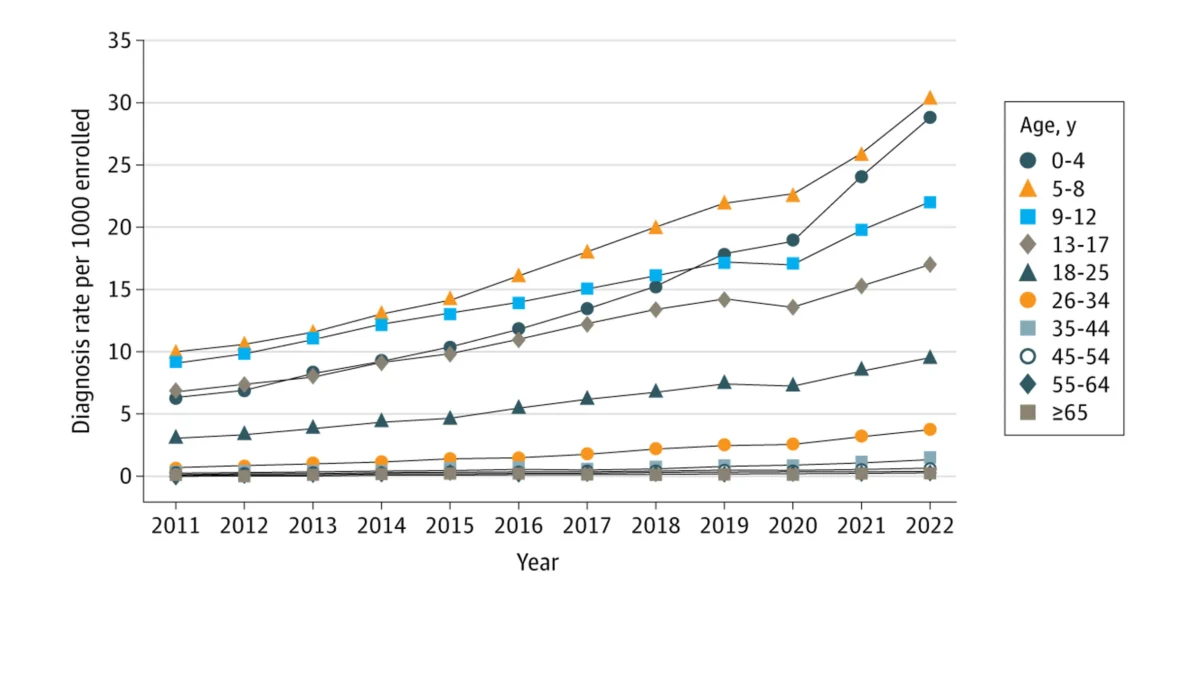Autism diagnosis rates have tripled and for some groups more than quadrupled over the last eleven years, a recent data review found.
The study, led by researchers at the Kaiser Permanente care consortium, analyzed data from 12 million people between 2011 and 2022, sourced from 12 delivery sites across the 8 health systems participating in the Mental Health Research Network.
Researchers found a 175 percent increase in autism spectrum disorder (ASD) for all age groups, growing from 2.3 per 1000 persons to 6.3 per 1000 persons.
ADS diagnosis jumped highest for young adults between ages 26 to 34, which saw a 450 percent increase within a decade.
The study authors said the sizeable increase could be explained in part because more people are being screened for autism and improved diagnosis methods, although they insist that other potentially contributing factors should continue to be explored in future research.
“The improvement and expansion of universal developmental screening likely accounts for some of the increase in diagnosis rates we found in this study,” said lead author Luke Grosvenor in a press release.
ADS is most prevalent among people under 18 (73 percent of all patients), while prevalence rapidly drops for age groups above 45 (2.8 percent of all patients). Among the above-65 age group, the study found less than 1 percent of individuals diagnosed with ADS (2 in 10,000 persons).
While males are about four times as likely to be diagnosed with ASD as females, the ASD rates increased faster in females than in males—305 percent versus 185 percent among children aged 0 to 17, and 315 percent versus 215 percent among adults.
The ASD diagnosis rate was greatest among 5-to-8-year-olds throughout the study period, tripling from about 10 per 1000 in 2011 to 30.3 per 1000 in 2022.

“The finding that the autism diagnosis rate was highest among 5-to-8-years olds was especially interesting to me, because it indicates that while we have made progress with universal screening, we must push forward in addressing barriers to timely autism evaluations,” said Melissa Maye, a co-author of the study associated with the Henry Ford Health’s Center for Health Policy and Health Services Research.
“Autism-specific health care services may not be available until a formal diagnosis is made—so early diagnosis is crucial,”
A more dramatic increase was observed in an earlier study conducted 2 decades apart that showed ASD prevalence among children in the US increased more than 4-fold, from 6.7 cases per 1000 (1 in 150) in 2000 to 27.6 per 1000 (1 in 36) in 2020.
The authors believe the real prevalence of ASD may yet be higher because many older people, especially women, were never diagnosed as children or later in life.
According to the Centers for Disease Control (CDC), ASD is a developmental disability caused by differences in the brain, some of which may be genetic.
While several studies have linked maternal exposure to glyphosate herbicides and other chemicals to ASD symptoms in offspring, the non-genetic factors contributing to the disability are still being researched.
People with ASD often have problems with social communication and human interaction, and may exhibit restricted or repetitive behaviors, according to the CDC.

